Simple Programs in C Language
In this article, we will discuss the basic programs in C language.
- Addition of two values in C.
- Swapping two values.
- Finding the odd or even values.
- Finding vowels and consonants in C.
- Finding the Fibonacci sequence in C.
- Finding Leap year in C.
- Checking if the number is Palindrome or Not.
- Check the number is an Armstrong Number or not.
- Finding the Factorial of a Number.
- Finding GCD of two numbers.
1. Program to add two values in C.
#include <stdio.h>
int main()
{
int n1, n2, sum;
printf(" Enter two integers : ");
scanf("%d %d", &n1, &n2);
// sum value of n1 and n2 //
sum = n1 + n2;
// printing the addition of 2 numbers //
printf( " %d + %d = %d ", n1, n2, sum);
return 0;
}
OUTPUT
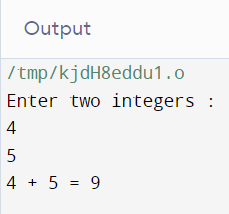
Explanation-
- The above code begins by including the stdio.h header file which provides functions for input and output operations in C.
- Next, the main() function is defined. This is the entry point of the program in C.
- Inside the main() function, three int variables are declared: n1, n2, and sum. n1 and n2 are used to store the two numbers entered by the user, and sum is used to store the sum of n1 and n2.
- The program then prints the message "Enter two integers: " using the printf() function.
- The scanf() function is used to read two int values from the standard input and store them in the n1 and n2 variables.
- The program then calculates the sum of n1 and n2 and assigns it to the sum variable.
- The program prints the sum of n1 and n2 using the printf() function.
2. Program for Swapping two values.
#include<stdio.h>
int main()
{
double first, second, temp;
// Entering first and Second number //
printf( " Enter first number : ");
scanf("%lf", &first);
printf( " Enter second number : ");
scanf("%lf", &second);
// Assigning the first value to the temp value //
temp = first;
// Assigning the second value to the first value //
first = second;
// Assigning the temp value to the second value //
second = temp;
// %.2lf displays number up to 2 decimal points //
// printing the values after swapping the numbers //
printf(" \n After swapping, first number = %.2lf \n ", first);
printf(" After swapping, second number = %.2lf ", second);
return 0;
}
OUTPUT
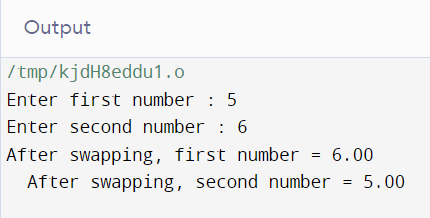
Explanation-
- Two variable’s values can be exchanged by swapping numbers in the C programming language. Consider that you have the variables first and second. 20 is the value of first variable and 40 is the value of second variable n. Thus, after swapping, the value of first variable becomes forty and the cost of second variable becomes twenty.
- The concept behind inserting a third variable to swap two integers is clear. Insert the first variable's value into a temporary variable.
- The second variable's value is saved in the first variable.
- Put the value of the temp variable in the second variable at the end. To keep the cost of the primary variable constant in our application, we are using a temporary variable.
Put the following formula into the temp variable: temp = first variable.
Affix first variable value to second variable as follows: first variable = second variable.
Put a temporary value in second variable: second variable = temp.
In above code, we followed the same procedure to swap two numbers using a temporary Variable.
3. Program to find odd or even value.
#include <stdio.h>
int main()
{
int num;
printf( " Enter an integer : ");
scanf("%d", &num);
// true if num is perfectly divisible by 2
if(num % 2 == 0)
{
printf(" %d is even ", num);
}
else
{
printf(" %d is odd ", num);
}
return 0;
}
OUTPUT
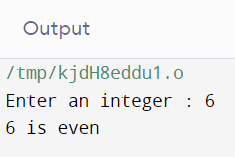
Explanation-
- The above code begins by including the stdio.h header file which provides functions for input and output operations in C.
- Then, the main() function is defined. This is the entry point of the program and all C programs.
- Inside the main() function, an int variable named num is declared. It is used to store the number entered by the user.
- The program then prints the message "Enter an integer: " using the printf() function.
- The scanf() function is used to read an int value from the standard input and store it in the num variable.
- The program then checks if the value of num is perfectly divisible by 2 using the % operator. If the value of num is perfectly divisible by 2, the remainder of num divided by 2 is 0.
- If the value of num is perfectly divisible by 2, the program prints that the given number is even using the printf() function. If the value of num is not perfectly divisible by 2, the program prints that the given number is odd.
4. Program to find vowels and Consonants in C.
#include <stdio.h>
int main()
{
int num;
printf( " Enter an integer : ");
scanf("%d", &num);
// true if num is perfectly divisible by 2
if(num % 2 == 0)
{
printf(" %d is even ", num);
}
else
{
printf(" %d is odd ", num);
}
return 0;
}
OUTPUT
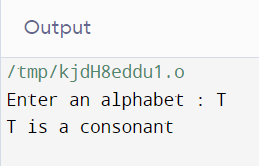
Explanation-
Descriptive logic to test vowels or consonants step by step.
- The code starts by including the stdio.h header file which provides functions for input and output operations in C.
- Inside the main() function, a char variable named c is declared. It is used to store the alphabet entered by the user. Two int variables named lowercase_vowel and uppercase_vowel are also declared. These variables are used to store whether the given alphabet is a lowercase vowel or an uppercase vowel respectively.
- The program then prints the message "Enter an alphabet: " using the printf() function.
- The scanf() function is used to read a char value from the standard input and store it in the c variable.
- The lowercase_vowel variable is then assigned the result of a logical expression which evaluates to 1 if c is a lowercase vowel and 0 otherwise. The uppercase_vowel variable is assigned the result of a similar logical expression which evaluates to 1 if c is an uppercase vowel and 0 otherwise.
- The program then checks if lowercase_vowel or uppercase_vowel is equal to 1 using an if statement. If either of the two variables is equal to 1, the program prints that the given alphabet is a vowel using the printf() function. If neither of the two variables is equal to 1, the program prints that the given alphabet is a consonant.
- The program then returns 0.
5. Program to find Fibonacci sequence in C.
#include<stdio.h>
int old_number;
int current_number;
int next_number;
int main()
{
old_number = 1;
current_number = 1;
printf(" Fibonacci Series are : \n ");
printf("1 ");
while (current_number<100)
{
printf(" %d ", current_number);
next_number = current_number + old_number;
old_number = current_number;
current_number = next_number;
}
return (0);
}
OUTPUT
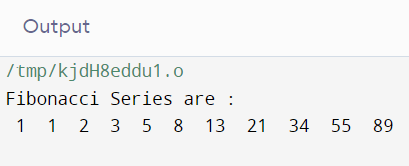
Explanation:-
- The code begins by including the stdio.h header file. This file contains declarations for the functions that are used in the code to read from and write to the standard input and output streams.
- The code then declares three integer variables: old_number, current_number, and next_number. These variables will be used to store the current, previous, and next numbers in the Fibonacci sequence.
- The code then defines the main() function, which is the entry point of the program.
- Inside the main() function, the old_number and current_number variables are initialized to 1, which are the first two numbers in the Fibonacci sequence.
- The code then prints the string "Fibonacci Series are: \n" to the standard output stream, followed by the first number in the sequence.
- The code enters a while loop that continues until the current_number is greater than or equal to 100. Inside the loop, it prints the current number, and calculates the next number in the sequence by adding the previous two numbers and stores it in the next_number variable. Finally, the code updates the old_number and current_number variables with the current and next numbers, respectively.
- Once the while loop is finished, returns 0.
6. Program to find the Leap year in C.
#include <stdio.h>
int main()
{
int year = 2004;
// leap year if perfectly divisible by 400 //
if (year % 400 == 0)
{
printf("%d is a leap year.", year);
}
// a leap year should not be divisible by 100 //
// Also, it should not be divisible by 400 //
else if (year % 100 == 0)
{
printf( " %d is not a leap year ", year);
}
// leap year if not divisible by 100 //
// but divisible by 4 //
else if (year % 4 == 0)
{
printf("%d is a leap year.", year);
}
// all other years are not leap years //
else
{
printf("%d is not a leap year.", year);
}
return 0;
}
OUTPUT
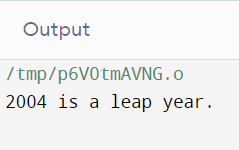
Explanation:
- The code begins by including the stdio.h header file. This file contains declarations for the functions that are used in the code to read from and write to the standard input and output streams.
- The code then defines the main() function, which is the entry point of the program.
- Inside the main() function, the code declares an int variable called year and initializes it to 2004.
- The code then checks if the year variable is divisible by 400. If it is, it prints a message to the standard output stream indicating that the year is a leap year.
- If the year variable is not divisible by 400, the code then checks if it is divisible by 100. If it is, it prints a message indicating that the year is not a leap year.
- If the year variable is not divisible by 100, the code then checks if it is divisible by 4. If it is, it prints a message indicating that the year is a leap year.
- If the year variable is not divisible by 400, 100, or 4, the code prints a message indicating that the year is not a leap year. The code then returns 0.
7. Program to cheek if the number is a Palindrome or Not.
#include <stdio.h>
int main()
{
int num, reverse_num = 0, remainder, original_num;
// Asking the user to enter a number //
printf("Enter a number: ");
scanf("%d", &num);
// Store the original number //
original_num = num;
// Reverse the number //
while (num > 0)
{
remainder = num % 10;
reverse_num = reverse_num * 10 + remainder;
num /= 10;
}
// Check if the original number is equal to the reversed number //
if (original_num == reverse_num)
printf("%d is a palindrome.\n", original_num);
else
printf("%d is not a palindrome.\n", original_num);
return 0;
}
OUTPUT
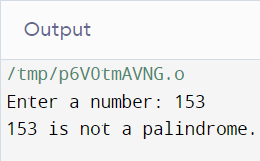
Explanation-
- The code starts by including the stdio.h header file which provides functions for input and output operations in C.
- The main() function is defined. This is the entry point of the program and all C programs.
- In the main() function, variables are declared: num, reverse_num, remainder, and original_num. num and original_num are used to store the number entered by the user and the original value of that number respectively.
- reverse_num is used to store the reversed version of num. remainder is used to store the remainder when num is divided by 10 in each iteration of the loop.
- The program then prints the message "Enter a number: " using the printf() function.The scanf() function is used to read an int value from the standard input and store it in the num variable.
- The value of num is then stored in the original_num variable to preserve the original value of num.
- The program then starts a while loop which continues to run until the value of num becomes less than or equal to zero. Inside the loop, the program calculates the remainder of num when divided by 10 and assigns it to the remainder variable using the % operator. The program then updates the value of reverse_num by multiplying it by 10 and adding the value of remainder.
- The value of num is then divided by 10 and the result is assigned back to num.
After the loop finishes, the program checks if the value of original_num is
equal to the value of reverse_num using an if statement.
- If the two values are equal, the program prints that the given number is a palindrome using the printf() function.
- If the values are not equal, the program prints that the given number is not a palindrome. The program then returns 0 .
8. Check the number is an Armstrong Number or not.
#include <stdio.h>
int main()
{
int num, originalNum, remainder, result = 0;
printf("Enter a three-digit integer: ");
scanf("%d", &num);
originalNum = num;
while (originalNum != 0)
{
// remainder contains the last digit //
remainder = originalNum % 10;
result += remainder * remainder * remainder;
// removing last digit from the orignal number //
originalNum /= 10;
}
if (result == num)
{
printf("%d is an Armstrong number.", num);
}
else
{
printf("%d is not an Armstrong number.", num);
}
return 0;
}
OUTPUT
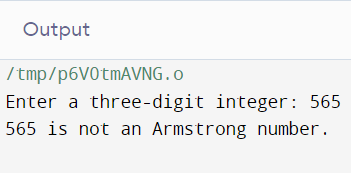
Explanation-
An Armstrong number is a number that is the sum of its own digits each raised to the power of the number of digits. For example, 371 is an Armstrong number because 3^3 + 7^3 + 1^3 = 371.
Here is a step-by-step explanation of a simple algorithm to check if a number is an Armstrong number.
First, we need to find the number of digits in the given number. This can be done by continuously dividing the number by 10 and incrementing a count variable until the number is less than or equal to zero.
Next, we need to find the individual digits of the given number. This can be done by using the modulo operator (%) to extract the last digit of the number, then dividing the number by 10 to remove that digit. This process can be repeated until the number is equal to zero.
We can now compute the sum of the digits each raised to the power of the number of digits. For example, if the number is 371 and the number of digits is 3, the sum would be 3^3 + 7^3 + 1^3.
Finally, we compare the sum we computed to the original number. If they are equal, the number is an Armstrong number. Otherwise, it is not.
9. Finding the Factorial of a Number.
#include <stdio.h>
int factorial(int n)
{
int result = 1;
for (int i = 1; i <= n; i++)
{
result *= i;
}
return result;
}
int main()
{
int n;
printf( " Enter a number : ");
scanf("%d", &n);
printf(" The factorial of %d is %d ", n, factorial(n));
return 0;
}
OUTPUT
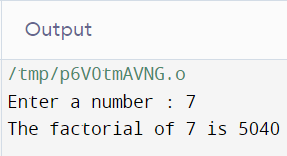
Explanation-
- First, we need to include the standard input/output library stdio.h to use the input/output functions in our program.
- Next, we defined a function named factorial() that takes an int as an argument and returns an int as the factorial of the given number.
- Inside the factorial() function, we defined a local variable result initialized to 1. This variable will store the result of the factorial calculation.
- We can use a for loop to iterate over the numbers from 1 to n, and multiply each number with the result variable to calculate the factorial.
- Finally, we can return the result variable as the factorial of n.
- We then used this function in the main() function to read a number n from the user, calculated the factorial of n, and printed the result.
10. Finding GCD of two numbers.
#include <stdio.h>
int gcd(int a, int b)
{
while (b != 0)
{
int r = a % b;
a = b;
b = r;
}
return a;
}
int main()
{
int a, b;
printf(" Enter two numbers : ");
scanf("%d %d", &a, &b);
printf(" The GCD of %d and %d is %d ", a, b, gcd(a, b));
return 0;
}
OUTPUT
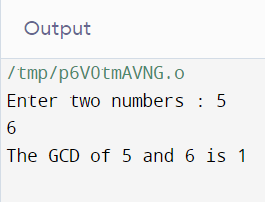
Explanation -
- In above code, firstly, we included the standard input/output library stdio.h to use the input/output functions in our program.
- Next, we defined a function named gcd() that takes two int as arguments and returns an integer as the GCD of the two numbers.
- Inside the gcd() function, we used a while loop to repeatedly calculate the remainder of a divided by b, and then swapped the values of a and b until b is equal to 0. At that point, the value of a will be the GCD of the two numbers.
- Finally, returned the value of a as the GCD of the two numbers.
- We then used this function in the main() function to read two numbers from the user, calculated the GCD of the two numbers using the gcd() function, and printed the result.